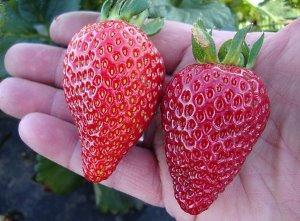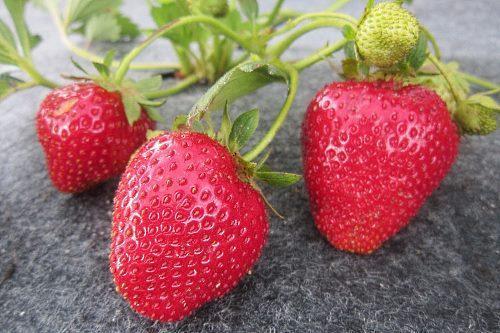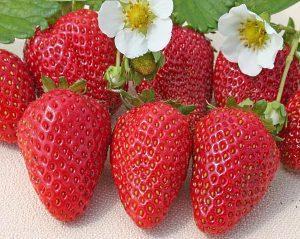The subtleties of planting and growing early, late and year-round varieties of strawberries
 It is difficult to surprise someone with a strawberry in its natural ripening season, and a much different effect can be produced by achieving a good result earlier or much later than usual, and it is absolutely great to learn the intricacies of growing berries all year round. Such a prospect will bring not only moral satisfaction to the gardener, but also significant profits, since in the winter season the price tags for strawberries are several times higher than the cost of berries in the high season.
It is difficult to surprise someone with a strawberry in its natural ripening season, and a much different effect can be produced by achieving a good result earlier or much later than usual, and it is absolutely great to learn the intricacies of growing berries all year round. Such a prospect will bring not only moral satisfaction to the gardener, but also significant profits, since in the winter season the price tags for strawberries are several times higher than the cost of berries in the high season.
Strawberries are among the varietal crops and there are an incredibly large number of them, and each of them has certain properties and other individual characteristics. This is expressed in the following:
- weight and size indicators of berries;
- full ripening time of fruits;
- resistance to all kinds of pest attacks;
- tolerance to temperature changes;
- soil adaptation parameters.
According to the varieties, the best varieties of strawberries are subdivided into varieties of purely local origin and varieties bred by crop selection (breeding). Local varieties, for the most part, are grown at an amateur level for personal pleasure, their advantage is easy adaptation to regional conditions and quite decent yield. But the cultivation of selective crops has already a more global development with the use of a certain number of technologies for mass cultivation in large agricultural complexes.

New technologies for year-round cultivation of strawberries
By resorting to traditional methods of cultivating a crop such as strawberries, you can get a quite decent harvest, but only once a year, many are quite satisfied with this state of affairs, but there are also such skilled gardeners who manage to shoot two or even three worthy crops in season.
To achieve such an excellent result, the following growing methods have been developed and tested more than once in practice:
- Drip irrigation;
- Hydroponics on a special substrate;
- Artificial lighting with the required wavelength;
- The use of systematic culture media.
Strawberry varieties for year-round cultivation
 Varieties that would have the property of bearing fruit continuously simply do not exist, therefore, in order to obtain effective results in practice, it is customary to use remontant strawberry varieties, these include the “Queen Elizabeth” or “Selva” variety. Plants of these species, provided with proper conditions and care, will bear fruit all year round. The correctness of the care is to timely replace the "spent" bushes with new ones.
Varieties that would have the property of bearing fruit continuously simply do not exist, therefore, in order to obtain effective results in practice, it is customary to use remontant strawberry varieties, these include the “Queen Elizabeth” or “Selva” variety. Plants of these species, provided with proper conditions and care, will bear fruit all year round. The correctness of the care is to timely replace the "spent" bushes with new ones.
In addition, strawberry varieties are divided according to their purpose:
- For indoor use. Such plants need to ensure a certain temperature regime, clear indicators of humidity and the required intensity of illumination.
- For open ground. Plant varieties are not picky about the quality and intensity of illumination, and also tolerate some changes in ambient temperature quite well.
Early varieties of strawberries
- Joseph Mohammed.Thanks to the powerfully developed root system, it is able to withstand even severe frosts, and is no less hardy to possible dry periods. The berries, although they do not differ in particular size, have an unobtrusive sweet and sour taste and delicate pulp.
- Alba. This early strawberry variety is highly valued for its large, bright red fruits that keep well, are resistant to pests and have excellent transportability.
- Octave. The variety is characterized by an unusually strong aroma, dense skin and pleasant juicy pulp.
- Marishka. Dry weather or disease isn't a problem for these incredibly sweet plants that taste like wild strawberries.
Late strawberry varieties
- Malvina. The latest variety, which has good taste even during prolonged rainy periods.
- Bohemia. High vitality is an aspect that is inherent in all late plants and late varieties of strawberries called "Bohemia" are the best confirmation of this. The berries are characterized by dense pulp with a pleasant taste and delicate aroma.
- Adria. The plant is resistant to almost all diseases of the root system, freezing. Will delight gardeners with large, bright red berries with a great taste.
- Symphony. Industrial variety of Dutch selection. The berries can withstand long shelf life, are quite transportable, and have an excellent sweet taste.
How to ensure the yield of strawberry crops
There are many sources of information on ensuring the correct care of strawberries, gardeners are pleased to not only demonstrate strawberry varieties, but share their skills and knowledge on how to achieve what they want to others.
Considering the fact that strawberries are among the crops that need intensive feeding, due attention should be paid to the choice of nutrients for it in the form fertilizersof organic origin. It is especially important to comply with all the rules of feeding during the growing season and fruiting.

Professional strawberry growers recommend combining varieties (early, mid-ripening, late) - this helps to ensure a virtually uninterrupted harvesting cycle.
Many amateur gardeners already learned to grow strawberries at homepractically turning your apartment into a kind of plantation. This has become possible largely thanks to well-thought-out simple technologies:
- Fans are used as pollinators;
- Sunlight is replaced specific lamps;
- For the convenience of harvesting, the substrate is enclosed in cellophane.